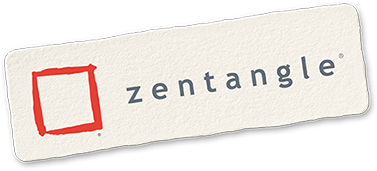On July 29, Ina Sonnenmoser sent us an email that said, in part, “I herewith request a public apology and removal of the blog post within 7 business days. Alternatively, you will face a lawsuit for defamation of character.”
We want to reduce the tension. So, we edited the original post to remove our analysis. The edited version appears below.
However, we need to maintain an online record of the specifics of the June 1, 2018, blog post that compared the Zentangle Method with what Ina calls her “intellectual property.”
-----+-----
When Ina Sonnenmoser of Germany offered “Certified CPT Coach” training in “Creative Pattern Tangling,” numerous people contacted us to express their concern. So, we took a closer look.
The quotes that follow are used in the same context as in their source documents:
- Creative Pattern Tangling – Beginners Guide – Vol 1
- Mindful Drawing & Creative Pattern Tangling – A guide for creating harmony in the brain through artful meditation
- Coaching Creative Pattern Tangling Vol 1
These quotes are either equivalent statements or direct quotes from our Zentangle books, our Zentangle website, or material that we teach in workshops and CZT seminars.
Ina describes:
- Using a “square artist tile,” “draw a border” in pencil to “define the area in which to draw.”
- Draw a “string” by “allowing your pencil to dance over the paper” in “loops, waves or straight lines to divide the area into sections. The individual areas can now be filled with patterns.”
- To “create a tangle” use “pigment pens” “with a nib size of 0.1.”
- “Fill the first section with the pattern.” “Focus on each line, take your time, do not think about the next stroke.” “Turn the tile” “multiple times” “ensuring a comfortable position for your hand.” “Draw all [straight] lines pointing downwards.”
- Using a standard pencil, add “shades of grey” and “add the finishing touch” so “your artwork will come to life” because shading “adds depth to the design.” Don’t be “overly concerned about the light source” because you “use shading to enhance a pattern.”
- Use a tortillion to “distribute the graphite” and push “the graphite further down between the fibers” of the paper.
- “The final step is to sign the artwork.”
Additionally:
- Patterns are based on shapes such as
- “line”
- “S-shape”
- “The circle or orb”
- “C-shape”
- Pattern “Step-Outs” use the Zentangle convention of red and black lines in sequential steps.
- “Some step-outs contain suggestions for variations (also known as tangleations) of the pattern.”
- When drawing circles “try drawing the shape the opposite way.”
- The “importance lies in the process, the tangling, not the outcome.”
- Tangles taught include:
- “Crescent Moon”
- “Printemps”
- “W2”
- “Shattuck”
- “Paradox”
- “Cadent” Reborn
- “Striping”
- Fife, renamed “Flower of Life”
- also:
- “aura”
- “highlighting” (our “sparkle”)
- “rounding”
There’s so much more — about muscle memory, “putting pen to paper,” pain management, relaxation, about not judging or grading artwork, about walking through a class and praising students’ artwork, about creating a state of “flow,” how to apply these principles to your life — all the things we write and talk about.
Additionally, “Coaching Creative Pattern Tangling Vol 1,” has a chapter “Money, money, money” where Ina describes how she expects Certified CPT Coaches to compensate her whenever one of them gives a class to a paying student. Ina writes [color and emphasis hers]:
Then in the next paragraph:
-----+-----
In a public letter to us, Ina wrote:
“First and foremost, please do not confuse CPTs way of creative drawing with your copyrighted method of teaching, as these are entirely different approaches as you would know.”
To research what differentiates “CPT’s way of creative drawing” from the Zentangle Method, we explored her website’s CPT section:
People familiar with the Zentangle Method can compare these statements with Zentangle’s “tangleations” and “reticula and fragments.”
-----+-----
The only quoted material used which is not related to the Zentangle Method are Ina’s comments on Karma and getting paid. Those limited quotes are included for the purpose of criticism and comment under the Fair Use Doctrine (Section 107 of the Copyright Act).
For your reference, here are the links for the documents quoted above.
-
Creative Pattern Tangling – Beginners Guide – Vol 1– US$5.00
http://pattern-collections.com/index.php/2018/05/21/creative-pattern-tangling/ -
Mindful Drawing & Creative Pattern Tangling – A guide for creating harmony in the brain through artful meditation.– (unavailable on May 31, 2018)
http://pattern-collections.com/index.php/2017/11/27/mindful-drawing-and-creative-pattern-tangling/ -
Coaching Creative Pattern Tangling Vol 1(unavailable on May 31, 2018)
http://pattern-collections.com/index.php/ebooks/become-a-creative-pattern-tangling-coach/
Rick and Maria
-----+-----
Postscript
Sacred Doodles and Carol Edmonston
In the original blog post, Ina posted links to articles which insinuate that we plagiarized Carol Edmonston’s “Sacred Doodles.”
Those insinuations are false.
We did not learn about Sacred Doodles until almost four years after we developed the Zentangle Method. As soon as we learned about it, we reached out to Carol and we informed the patent office.
- Fall of 2003, we develop the Zentangle Method.
- September 19, 2005, we file a patent application.
- Around January of 2006,* we learn about Sacred Doodles. We reach out to Carol. We send her a letter and a Zentangle Kit. We may have had a phone conversation, but we’re not sure; it was over a decade ago. [Updated below**]
- January 27, 2006,*July 18, 2007, we file an Information Disclosure Statement with the Patent Office informing them of our discovery of Carol’s work. As patent filers, we are obligated to report any potential prior art we discover, even after we file our initial claim. The date and contents of our disclosure are a matter of public record.
-----+-----
If you find any errors of fact in this blog post, please let us know.
Thank you.
Rick and Maria
-----
* August 3, 2018 -- We filed our first Information Disclosure Statement with the Patent Office regarding Sacred Doodles on January 27, 2006, not July 18, 2007 as first stated. We resubmitted it on July 18, 2007, in the format for websites as requested by the Patent Office.
** August 3, 2018 --Carol recently responded in one of the blogs Ina posted which falsely insinuates and wrongfully states that we plagiarized Carol's work. Carol confirms that we did have a conversation and that our approaches are different from each other. Carol wrote (in part):
"I can’t remember exactly when Rick and Maria contacted me, but we did connect. For me it was refreshing to connect with other ‘doodler’s, especially those open to exploring the world through spiritual study. I can’t remember what path they were on, but mine is based on Hindu teachings. After our conversation, they sent me one of their Zentangle kits. What became apparent to me, was while we shared similar thoughts about the benefits of doodling, our approach to the “how to” was different."


Pointing out that Nadia Russ and Carol Edmoston did repetitive pattern art illustrates that you are not the “creator” or “inventor” of this type of art. Neither are they. Repetitive pattern art has been around since nearly the beginning of time.
If Ina or anyone else ever decide to make money from this, why not? You do. Maybe some like your method and others like Ina’s. Just like some like Coke and others like Pepsi. Both cola sodas but yet a bit different.
Why do you do nothing to dispel the incorrect information that the “method” of Zentangle has a copyright? Here is a quote from your web page… "We’ve discovered that people inevitably want to share the Zentangle Method and art
form with others. After teaching a Zentangle workshop at our grandson’s second grade class, by the next day children throughout the school were creating their own Zentangle art! The Zentangle Teaching Method is copyrighted. We describe our thoughts on non-commercial small scale sharing vs. commercial teaching on this page. Any questions, please let us know. " I have researched online about copyright and came up with this …
What Is Not Protected by Copyright
Copyright law does not protect ideas, methods, or systems. Copyright protection
is therefore not available for ideas or procedures for doing, making, or
building things; scientific or technical methods or discoveries; business operations
or procedures; mathematical principles; formulas or algorithms; or any
other concept, process, or method of operation.
Section 102 of the Copyright Act (title 17 of the U.S. Code) clearly expresses
this principle: “In no case does copyright protection for an original work of
authorship extend to any idea, procedure, process, system, method of operation,
concept, principle, or discovery, regardless of the form in which it is described,
explained, illustrated, or embodied in such work.”
Inventions are subject matter for patents, not copyrights. For information
about patent laws, contact
Commissioner for Patents
U. S. Patent and Trademark Office
P. O. Box 1450
Alexandria, VA 22313-1450
(800) 786-9199
www.uspto.gov
If you have a copyright please post it so we can see it. I applaud your business savvy in creating a business doing something you obviously enjoy. You have a loyal following and have made many connections around the world. I find it sad that someone who promotes “Zen” and “healing” would at the same time deceive people into believing that only a CZT can teach repetitive pattern art….and yes, I called it art, as that is what I practice. I don’t create art to be “zen”. I do it for the sheer joy of creating. I don’t limit myself by having rules about no erasers, rulers, etc. I use what ever size paper I want, whatever medium I feel like using. Some of my work is representational and some not. Some black and white and other in color. Watercolor, ball point pen, markers, Copic, colored pencil, etc. I’ve tried it all.
I think that in the world of art there is room for everyone. If you are interested in my art work check out Tricia’s Tangle Art Studio on FB. I choose to practice “Creative Pattern Tangling”.
Tricia Long on
Alice hendon on